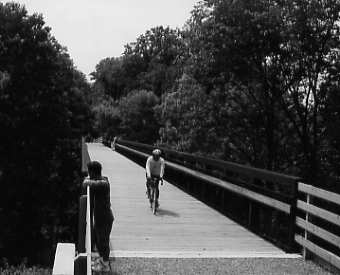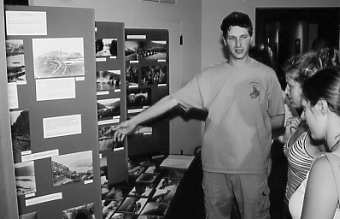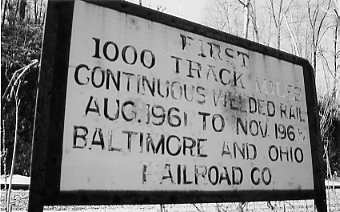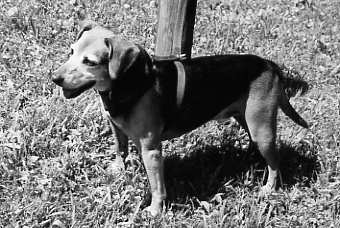
July 2003
Rock Creek Trestle Opened for Trail Use

[By Allen Brougham] . . .
The 80-foot-high former railroad trestle spanning Rock Creek in Montgomery County, Maryland, was officially opened to the public on May 31. It is part of the latest extension to the Georgetown Branch Trail in Chevy Chase for use by hikers and bikers. The $1.3-million rebuilding project involved reinforcement of the trestle, wood plank flooring, railings and observation decks. The bridge was once part of the B&O's 11-mile-long Georgetown Branch connecting Georgetown along the Potomac River in Washington with the Metropolitan Subdivision in Silver Spring. The rail line was in service from 1910 until 1985.
The Georgetown Branch Trail is an extension of the Capital Crescent Trail which uses the former B&O route with a seven-mile paved surface from Georgetown to Bethesda. A three and one-half-mile gravel-based surface under the interim Georgetown Branch Trail moniker extends from Bethesda on both sides of the reopened trestle to a point about half a mile west of where the rail line connected with the Metropolitan Subdivision. Eventual plans are to name the entire 11-mile portion from Georgetown to Silver Spring as the Capital Crescent Trail with a paved surface, but there is still a proposal to use the interim portion as a transit-way which may or may not include space for a permanent trail next to it.
The last time I had visited the Capital Crescent Trail was in September 1998. I was accompanied that time by my biking buddy Gilbert Elmond as we pedaled from Georgetown to Bethesda with a further visit along the gravel portion as far as the trestle. Since trains last used the line following the end of rail service, the trestle had been damaged by fire. The recent rebuilding of the trestle for trail use was the vital link that was needed to open the trail further along to Brookville Road in Silver Spring where it now ends just shy of the full length of the former rail line.
Anxious to get back on the trail to complete the needed mileage, I was once again joined by Gilbert as we biked from near the Georgetown end to the Rock Creek Trestle and beyond on June 8, just a couple of weeks after the trestle was reopened. The trail gradually climbs from Georgetown to a point where it juxtaposes the towpath of the C&O Canal for about a mile, and then climbs further and crosses the canal on the steel-truss Canal Bridge, then continues to climb away from the canal and through the 341-foot Dalecarlia Tunnel. It is mostly uphill as the trail passes through upscale neighborhoods into Bethesda. It was a good day for biking, and many folks were out and about enjoying the same thing as we.
There is a rather challenging intersection at Bethesda (walking though the maze like complex is recommended), and then the trail passes through a tunnel beneath the Air Rights Complex to the point where the trail reaches its highest elevation.
Beyond this point the gravel-based surface of the "interim" trail begins. A couple of miles later we reached the trestle. It was here that we paused to reconnoiter, take photos and chat with other trail users. The observation decks, which extend more than a yard to either side near the midway point of the bridge, were funded by a $130,000 donation from the wonderful folks comprising the Coalition for the Capital Crescent Trail, Greater Bethesda-Chevy Chase Coalition and Washington Area Bicycle Association. The decks are a superb adjunct to the trestle where folks may stage themselves and equipment away from the through flow of hiking and biking traffic. Down below can be seen another trail, the one which follows Rock Creek Park.
From the trestle onward to the Silver Spring end of the trail, the gravel surface retrogresses somewhat; at the extreme end it is nothing more than a narrow path through weeded and unkempt terrain. Even if this is only an "interim" trail, it is far less than what one could expect following such a masterful and costly upgrade to the bridge that made access to this part of the trail possible. This opinion is not mine alone. Dale Jacobson, a regular correspondent to the Bull Sheet who bikes often (sometimes with a unicycle), wrote: "As you continue north towards Silver Spring, the trail continues to deteriorate until it ends as a mere dirt path near a junk yard no wider than to allow one hiker or biker to use the trail at one time. Hopefully, this will change."
Gilbert and I even went one step further. We hiked along the old right of way to the end of the line where it connected with the Metropolitan Subdivision in Silver Spring (control point Georgetown Junction). The half-mile we covered through weeds and rubbish was only slightly less inviting than the official end of the trail we had just vacated. Interestingly, I had already covered a portion of this area in 1992 - aboard a freight train - when the track was still in service as a switching area to an industry. In any event, I now have my needed mileage on the Georgetown Branch.
Returning, we stopped at a high-style steak house in Bethesda, one which at I had wanted to dine an obligatory one time during my life. More than ninety bucks later (a fine meal for two), we left, and then attempted a speed run back to our original starting point. "Speed," as defined here, was contingent upon the number of other trail users we encountered and enough clearance to get around them. Still, we made such good time that we decided to cycle into the main part of Georgetown and its trendy waterfront before heading back to Fletcher's Boathouse, from which we had started.
B&O Photo Exhibit Opens at Harpers Ferry

[By Allen Brougham] . . .
Robbie Brzostowski, also known as "Railroad Rob," has been taking railroad photographs since he was a kid. Now his talents and his keen sense of history have gained him some noted recognition. On June 30 he opened a photo exhibit with space provided for the purpose by the National Park Service in the old town area of Harpers Ferry, West Virginia.
Entitled "B&O, 169 Years at Harpers Ferry," the exhibit will be displayed throughout the summer on the first floor of the Master Armorer's House on Shenandoah Street in the Harpers Ferry National Historical Park.
Many of the photos on display were taken by Robbie, but he has also arranged a number of archival photos - some never before exhibited - to document the B&O's historical import to the town.
The exhibit opened in time for the celebration of the 175th anniversary of the founding and commencement of construction of the B&O. But as fate would have it, the room slated for the exhibit was in the process of being painted, so the opening was staged on the second floor of the John Brown House. This necessitated a reduced exhibit - about 47 of the planned 75 images - until it can be moved into the intended space early this month. About 30 people assembled in the John Brown House for the official opening, which included brief remarks by Robbie and a question and answer period.
As reported in the Bull Sheet earlier, Robbie - whom I have known since 1992 - was extensively involved last year for his assistance in researching the history of the B&O station at Harpers Ferry for the National Park Service Archaeology Department and documenting the condition of the station as part of a team working with the Historic American Engineering Record.
The station, designed by famed architect E. Francis Baldwin, was constructed in 1894 and stood about 800 feet south of its current location. It was relocated in 1931 when the B&O built a new mainline bridge to upgrade its route through Harpers Ferry and bypass a heretofore tight curvature. A two-story interlocking tower near the east end of the building was removed in 1950, but an operator maintained local control from the station's ticket office until 1986. The station - which is still used by train passengers - is now owned by the National Park Service, and there are plans to restore the building and cosmetically reconstruct its former interlocking tower.
Forgotten B&O Sign Keeps Unseen Vigil

[By Allen Brougham] . . .
The B&O was a very proud railroad. It was so proud of its accomplishments that it strived to keep its adoring public duly informed.
Such as it was in 1965 that its feted accomplishment in laying its first 1000 track miles of continuous welded rail was promulgated in a sign erected for all the world to see. The sign did not face the tracks (its employees already knew of the endeavor), but toward a highway.
Motorists who plied U.S. Route 40 could see the sign on the embankment along the B&O's Old Main Line at a point where the railroad and the highway were in close proximity about midway between Mount Airy and New Market in Frederick County, Maryland.
The sign is still there.
But years of growth have obliterated the sign from public view. Moreover, even if the sign could be seen, its paint has deteriorated to the point that it probably could not even be deciphered from that distance.
U.S. Route 40 at this point is now Interstate 70 (although the route 40 designation still coexists). Its location on the railroad (now CSXT) is several hundred yards west of the control point known as West Plane.
In the winter, with leaves off the invading trees, one might catch a glimpse of the sign - if you know exactly where to look - but only for a fleeting instant. In summer months, the sign is completely hidden from view.
The above photo was taken early this year after I did some backwoods hiking. The sign is still visible at close range, but some of the letters have been extensively weathered. The sign reads:
FIRST
1000 TRACK MILES
CONTINUOUS WELDED RAIL
AUG.1961 TO NOV.1965
BALTIMORE AND OHIO
RAILROAD CO.
The digit '5' in 1965 appears to have been repainted from another digit.
Rex Becomes a "Senior Citizen"

[By Allen Brougham] . . .
Rex, my faithful hound dog of Miller Tower fame, has now reached the ripe old age of 62. Golly, that's my age, too. So welcome to the club, old boy!
Admittedly, a certain amount of conjecture went into this observation. For one thing, I do not actually know how old he was when I adopted him - er, I mean, when HE adopted ME. That was in February 1994. But assuming that he was a year old when we first met, he would be at least ten years old today. Anyway, just to keep things simple, I celebrate his birthday each year on December 16. That was Ludwig Beethoven's birthday Oh yes, it's MY birthday, too!
Rex, for those who don't know (or have forgotten), appeared at Miller Tower, my heralded workplace at the time, during a snowstorm. He wore no collar. He stayed... and he stayed... and he stayed. He was a very friendly dog, and he soon claimed the top landing just outside the tower door as his 'post.' There, from his lofty perch, he could keep an eye on all that happened, and he made himself a committee of one to welcome all who came to his adopted domain.
And what a thrill it was each day to arrive at the tower to Rex's friendly greeting. He would show his delight at my arrival by the tones of an especially happy bark, and by placing his front paws (mud and all) against the door of my car (and then against me when I got out). He also thrilled at grabbing my arm with his teeth in a most friendly sort of way.
As time went on, attempts were made to find his rightful owner. We checked the lost and found notices in the paper. Also, photos of Rex were affixed to posters and displayed at nearby convenience stores explaining his plight. There was no response - not even a nibble (no pun intended). Finally, after four weeks of his presence at the tower, I took Rex home with me. He has been a happy member of the household ever since.
So how do I arrive at the exacting conclusion that Rex is now 62? Indeed, many folks subscribe to the idea that dogs advance seven years to every year a person advances by one. By this measure, Rex would now be 70. But the seven-for-one scale is not realistic, in my opinion, at either end of the spectrum. For starters, dogs typically achieve about 90 percent of their adult growth in the first year. But humans do not achieve the equivalent growth in a mere seven years. Moreover, on the upper end of the scale, dogs (depending upon their breed) can live 16 years or longer. A 16-year-old dog, using the seven-for-one formula, would equate to a 112-year-old human. Again, not very realistic..
So now comes Allen's formula for charting a dog's age in human years (you dog lovers, take note): For the first year (dog) it is 15 years (human). Thereafter, for each year in a dog's life, add five human years. Neat, eh! And it's easy to figure, too.
So if Rex were 60 on his last attributed birthday - the day I turned 62 - then he would have turned 62 on May 11. (That's calculated 365, divided by five, times two.)
But wait: He had still not achieved my age; I was getting a little older at the same time myself! So to set things straight (and using a little more arithmetic), good old Rex finally caught up with me in age on June 16. That's the day we both turned 62 and one-half. Happy birthday-and-a-half to both of us! Not only are we now both senior citizens - he is now even older than I.
Rail Corridors Planned for Chicago
The city of Chicago, the state of Illinois and a partnership of Class I railroads have announced plans for the creation of five rail corridors in and around Chicago, one of which will be primarily for passenger trains to speed their flow and eliminate commuter delays. The plan will also open for commercial development a key corridor in downtown Chicago. The total cost of the project is estimated at $1.5-billion, of which railroads are committing more than $200-million. It is expected to take six years to complete.
EMD Launches SD70ACe Locomotive
General Motors Electro-Motive Division has announced the launch of a new freight diesel locomotive, model SD70ACe, which surpasses new emissions tier 2 standards set by the Environmental Protection Agency for 2005. The first four SD70ACe locomotives have been built and are being tested to verify that all performance and reliability requirements are satisfied, according to a press report.
NJ Transit Awards Environmental Study for Twin-Tube Tunnel
New Jersey Transit has awarded a $4.9-million contract for an environmental impact study on a new twin-tube rail tunnel between New Jersey and Manhattan to the engineering firm of Parsons Brinkenhoff & Systra. The study is slated for completion by 2005. The entire tunnel project is estimated to cost up to $5-billion and take more than 10 years to complete.
CSXI, CN to Build Super Terminal in Memphis
[CSXT Midweek Report, June 19, 2003] . . . CSX Intermodal and Canadian National Railway Company have reached an agreement with city officials to develop and operate the Memphis Super Terminal, a state-of-the-art railroad-truck intermodal facility in Memphis, Tennessee. The new 155-acre terminal, planned to be operational in 2004, will have an annual capacity of 200,000 "lifts" of intermodal containers, or trailers. The City of Memphis and Shelby County jointly own the Frank C. Pidgeon Industrial Park, where the terminal will be located. The new location offers more than 3,000 acres for industrial development with ample land available for expansion of the Super Terminal.. "The Super Terminal will further secure Memphis' role as the distribution hub of the United States," said Memphis Mayor Willie Herenton. "The partnership that the city and the Port Commission have forged with CN and CSXI will improve intermodal service to our existing industries, attract more job-creating industry to our area, and spur industrial development." CSXI and CN currently co-operate another, smaller terminal in Memphis that is at capacity.. "CSXI and CN jointly designed the Memphis Super Terminal to be the premier intermodal terminal in the Memphis market," said Michael Ward, chairman and CEO of CSX Corporation. "Intermodal business in this market is growing, and the new Memphis Super Terminal will provide our customers with an excellent location, superior service and capacity for business growth."
CSX, NS Seek Direct Ownership of Conrail Subsidiaries
[CSXT Midweek Report, June 5, 2003] . . . CSX Corporation, Norfolk Southern Corporation and Consolidated Rail Corporation have jointly filed a petition with the Surface Transportation Board to establish direct ownership and control by CSXT and Norfolk Southern Railway, respectively, of two Conrail subsidiaries - New York Central Lines LLC (NYC) and Pennsylvania Lines LLC (PRR). CSXT and NSR are currently managing and operating NYC and PRR under operating agreements approved by the STB in 1998. The proposed transaction would replace the existing operating agreements and allow CSXT and NSR to operate NYC and PRR via direct ownership. The petition, if approved, would make the financial, operational and administrative management of Conrail, NYC and PRR more efficient in an increasingly competitive transportation environment and facilitate CSX and NS capital investment in those properties. The proposed transaction would not affect rail operations, service or competition, and would have no adverse effect on customers or the employees of CSXT and NSR. The proposed transaction does not involve the Conrail Shared Assets areas of northern New Jersey, southern New Jersey/ Philadelphia and Detroit. Conrail would continue to own, manage and operate the Shared Assets areas as previously approved by the STB.